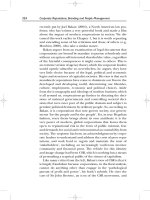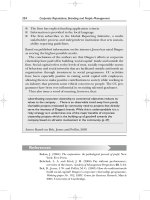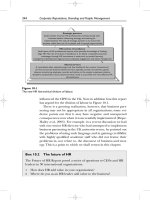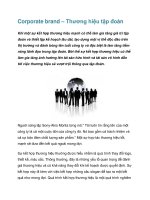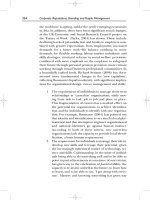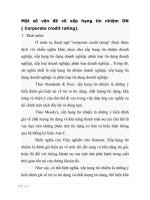Lecture no32 corporate income taxes
Bạn đang xem bản rút gọn của tài liệu. Xem và tải ngay bản đầy đủ của tài liệu tại đây (823.27 KB, 28 trang )
Corporate Income Taxes
Lecture No. 32
Chapter 9
Contemporary Engineering Economics
Copyright © 2016
Contemporary Engineering Economics, 6 th edition
Park
Copyright © 2016 by Pearson Education, Inc.
All Rights Reserved
Taxable Income and Income Taxes
Item
Gross Income
Expenses
Cost of goods sold (revenues)
Depreciation
Operating expenses
Taxable income
Income taxes
Net income
Contemporary Engineering Economics, 6 th edition
Park
Copyright © 2016 by Pearson Education, Inc.
All Rights Reserved
U.S. Corporate Tax System
• For corporations, the U.S. tax system has the following
characteristics:
1. Tax rates are progressive; the more you earn, the
more you pay.
2.
Tax rates increase in stair-step fashion; four
brackets for corporations and two additional surtax
brackets, giving a total of six brackets.
3.
Allowable exemptions and deductions may
reduce the overall tax assessment.
Contemporary Engineering Economics, 6 th edition
Park
Copyright © 2016 by Pearson Education, Inc.
All Rights Reserved
U.S. Corporate Tax Rate (2016)
Taxable income
Tax rate
0–$50,000
15%
$50,001–$75,000
25%
$75,001–$100,000
34%
$100,001–$335,000
39%
$335,001–$10,000,000
34%
$10,000,001–$15,000,000 35%
$15,000,001–$18,333,333 38%
$18,333,334 and up
35%
Tax computation
$0 + 0.15(Δ)
$7,500 + 0.25 (Δ)
$13,750 + 0.34(Δ)
$22,250 + 0.39 (Δ)
$113,900 + 0.34 (Δ)
$3,400,000 + 0.35 (Δ)
$5,150,000 + 0.38 (Δ)
$6,416,666 + 0.35 (Δ)
(Δ) denotes the taxable income in excess of the lower bound
of each tax bracket
Contemporary Engineering Economics, 6 th edition
Park
Copyright © 2016 by Pearson Education, Inc.
All Rights Reserved
Marginal versus Average Tax Rate
Marginal tax rate is the rate applied to the
last dollar of income earned.
Average (effective) tax rate is the ratio of
income tax paid to net income.
Contemporary Engineering Economics, 6 th edition
Park
Copyright © 2016 by Pearson Education, Inc.
All Rights Reserved
Marginal and Effective (Average) Tax Rate for a
Taxable Income of $16,000,000
Taxable income
Marginal Tax
Rate
Amount of
Taxes
Cumulative
Taxes
First $50,000
15%
$7,500
$7,500
Next $25,000
25%
6,250
13,750
Next $25,000
34%
8,500
22,250
Next $235,000
39%
91,650
113,900
Next $9,665,000
34%
3,286,100
3,400,000
Next $5,000,000
35%
1,750,000
5,150,000
Remaining
$1,000,000
38%
380,000
$5,530,000
A v e r a g e ta x r a t e =
$ 5 ,5 3 0 ,0 0 0
3 4 .5 6 %
$16,000 ,000
Contemporary Engineering Economics, 6 th edition
Park
Copyright © 2016 by Pearson Education, Inc.
All Rights Reserved
Example 9.13: Corporate Taxes
Given: Financial data
•Capital expenditure: $100,000
–(Allowed depreciation): $58,000
•Gross sales revenue: $1,250,000
•Expenses
–Cost of goods sold: $840,000
–Depreciation: $58,000
•Leasing warehouse: $20,000
Find:
(a)
Taxable income?
(b)
Income taxes?
(c)
Average tax rate?
(d)
Marginal tax rate?
Contemporary Engineering Economics, 6 th edition
Park
Copyright © 2016 by Pearson Education, Inc.
All Rights Reserved
Solution
•
(a) Taxable income
•
(b) Income taxes
•
•
(c) Average tax rate: $112,730/$332,000 = 33.93%
(d) Marginal tax rate: 39%
Contemporary Engineering Economics, 6 th edition
Park
Copyright © 2016 by Pearson Education, Inc.
All Rights Reserved
Capital Gains and Losses
Capital gains are currently taxed as ordinary
income, and the maximum rate is capped at
35%.
Capital losses are deducted from capital
gains; net remaining losses may be carried
backward (3 years) and forward 15 years for
consideration in years other than the current
tax year.
Contemporary Engineering Economics, 6 th edition
Park
Copyright © 2016 by Pearson Education, Inc.
All Rights Reserved
Tax Treatment of Gains or Losses on
Depreciable Assets
If a MACRS property is disposed of during the
recovery period
o Personal property: the half-year
convention is applied to depreciation
amount for the year of disposal.
o Real property: the mid-month convention
is applied to the month of disposal.
Contemporary Engineering Economics, 6 th edition
Park
Copyright © 2016 by Pearson Education, Inc.
All Rights Reserved
Disposal of a MACRS Property and Its
Effect on Depreciation Allowances
Contemporary Engineering Economics, 6 th edition
Park
Copyright © 2016 by Pearson Education, Inc.
All Rights Reserved
Case 1: Salvage Value < Cost Basis
• Ordinary gains (losses) =
salvage value − book value
• These gains, known as
depreciation recapture, are
taxed as ordinary income.
• Any losses (ordinary) can be
deducted from the ordinary
gains from other assets first
and any remaining balance
can be deducted from the
ordinary taxable income.
Contemporary Engineering Economics, 6 th edition
Park
Copyright © 2016 by Pearson Education, Inc.
All Rights Reserved
Case 2: Salvage Value > Cost Basis
Gains = Salvage value − book value
= (Salvage value − cost basis)
Capital gains
+ (Cost basis − book value)
Ordinary gains
Capital gain is taxed as ordinary income
under current tax law.
Contemporary Engineering Economics, 6 th edition
Park
Copyright © 2016 by Pearson Education, Inc.
All Rights Reserved
Example 9.15: Gains or Losses on
Depreciable Asset, Case 1
Given:
o
o
o
o
Cost basis for a drill press: $230,000
Recovery period: 7-year MACRS
Sold the drill press after 3 years at $150,000
Tax rate for capital gains and ordinary gains: 34%
Find:
o Taxable gains
o Net proceeds from sales
Contemporary Engineering Economics, 6 th edition
Park
Copyright © 2016 by Pearson Education, Inc.
All Rights Reserved
Solution
• Depreciation schedule
0.1439
0.2449
0.1749/2
o Total dep. = 230,000(0.1439 + 0.2449 + 0.1749/2) = $109,308
o Book value = 230,000 − 109,308 = $120,693
o Gains = salvage value − book value = $150,000 − $120,693 =
$29,308
o Gains tax (34%) = 0.34 ($29,308) = $9,965
o Net proceeds from sale = $150,000 − $9,965 = $140,035
Contemporary Engineering Economics, 6 th edition
Park
Copyright © 2016 by Pearson Education, Inc.
All Rights Reserved
Calculation of Gains or Losses on MACRS Property, Cases
2–4
Contemporary Engineering Economics, 6 th edition
Park
Copyright © 2016 by Pearson Education, Inc.
All Rights Reserved
What Income Tax Rate Should Be Used in
Project Analysis?
Incremental tax rate is the average rate applied to the incremental
income generated by a new investment project.
Incremental tax rate to be used in
project cash flow analysis
Contemporary Engineering Economics, 6 th edition
Park
Copyright © 2016 by Pearson Education, Inc.
All Rights Reserved
Illustration of Incremental Tax Rate
0.25($5,000/$20,000) + 0.34($15,000/$20,000) = 31.75%
$20,000 incremental
taxable income due to
undertaking project
Regular income from operation
$5,000
at 25%
Marginal tax rate
15%
$0
$20,000
25%
$40,000
Contemporary Engineering Economics, 6 th edition
Park
$60,000
$15,000
at 34%
34%
$80,000
$100,000
Copyright © 2016 by Pearson Education, Inc.
All Rights Reserved
Consideration of State Income Taxes
ttm
f
tts ( f )(t s )
where
tm combined marginal tax rate
t f federal marginal tax rate
t s state marginal tax rate
Example: Given tf = 35% and ts = 7%
Find: tm
Combined tax rate = 0.35 + 0.07 − (0.35)(0.07)
= 39.55%
Contemporary Engineering Economics, 6 th edition
Park
Copyright © 2016 by Pearson Education, Inc.
All Rights Reserved
Example 9.17: Combined State and
Federal Income Taxes
Given: Financial Data
o Gross revenue = $1,000,000
o All expenses = $400,000
o tf = 35%, ts = 7%
o tm = 0.35 + 0.07 − (0.07)(0.35) = 39.55%
Find: Combined income taxes
Contemporary Engineering Economics, 6 th edition
Park
Copyright © 2016 by Pearson Education, Inc.
All Rights Reserved
Solution
Approach 1
o State taxable income = $600,000
o State taxes = (0.07)($600,000) = $42,000
o Federal taxable income
= $600,000 − $42,000
= $558,000
o Federal taxes = (0.35)($558,000)
= $195,300
Approach 2
o (0.3955)$600,000 = $195,300
Contemporary Engineering Economics, 6 th edition
Park
Copyright © 2016 by Pearson Education, Inc.
All Rights Reserved
Cash Flow vs. Net Income
Net income: an accounting means of measuring a firm’s
profitability based on the matching concept.
o Costs become expenses as they are matched against
revenue.
o The actual timing of cash inflows and outflows are
ignored.
Cash flow: Considering the time value of money, it is better
to receive cash now than later, because cash can be invested
to earn more money. So, cash flows are more relevant data
to use in project evaluation.
Contemporary Engineering Economics, 6 th edition
Park
Copyright © 2016 by Pearson Education, Inc.
All Rights Reserved
Example 9.18: Net Income Calculation
Given: Project description
o
o
o
o
o
o
Purchased an equipment costing $28,000
Gross income: $50,000/yr
Cost of goods sold: $20,000/yr
Operating expenses: $6,000/yr
Depreciation method: 7-year MACRS
Income tax rate: 40%
Find: The net income during the first year of
operation
Contemporary Engineering Economics, 6 th edition
Park
Copyright © 2016 by Pearson Education, Inc.
All Rights Reserved
Solution
Item
Amount
Gross income (revenue)
$50,000
Expenses:
Cost of goods sold
Depreciation
Operating expenses
20,000
4,000
6,000
Taxable income
20,000
Taxes (40%)
8,000
Net income
$12,000
Contemporary Engineering Economics, 6 th edition
Park
Copyright © 2016 by Pearson Education, Inc.
All Rights Reserved
Capital Expenditure versus Depreciation
Expenses
0
$28,000
0
1
2
3
4
5
6
7
8
4
7
6
7
8
Capital expenditure
(actual cash flow)
1
$4,000
2
3
$3,500 $2,500 $2,500 $2,500
$1,250
$4,900
$6,850
Allowed depreciation expenses (not cash flow)
Contemporary Engineering Economics, 6 th edition
Park
Copyright © 2016 by Pearson Education, Inc.
All Rights Reserved

